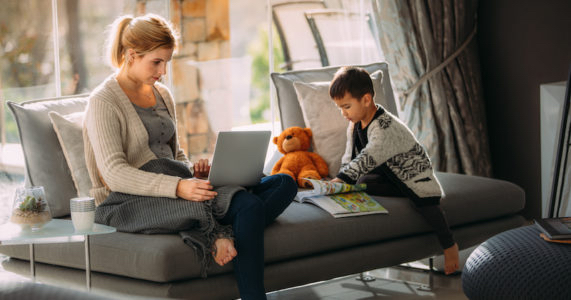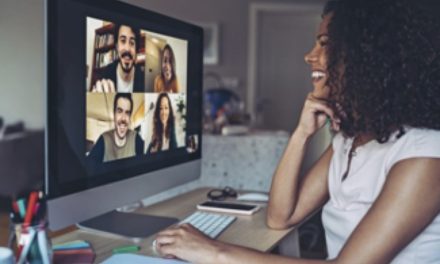The COVID-19 pandemic has resulted in the most rapid transformation of the workplace. Form the past couple of months, businesses are not working quite as usual. The situation is really challenging for employers and has forced them to adopt new ways of working. Remote working has become the new normal and we have gone digital to interact between employer, employees, and clients.
Though working from home can make life easier at first, but for the long term it can actually be harmful to employees' mental health.
Following COVID-19, most of us have transformed overnight from office goers into telecommuters. To interact with our peers, we have gradually done endless video calls and are struggling to balance work and personal responsibilities together.
Online meetings have made our personal lives visible. We may have taken meetings in odd places like a bathroom or closet so as to avoid kids or pets popping up on the screen during video calls with colleagues. While some employees give up and let their kids and pets be a part of the meeting.
Our personal and professional lives are beginning to merge and sometimes awkward situations have arrived.
The pandemic presents a possibility to restructure the workplace environment for a post-COVID-19 reality.
How will our jobs change in a post COVID scenario?
- The New Work Culture : Home and Online
Remote working has helped us to realize the power of communication via digital mediums/tools. Virtual meetings through collaborative platforms can easily replace in-person meetings. With time, companies have learned that daily tasks can be easily carried out online, rather than one being physically present. They urged people to consider work from home, as this new work model with technology seems to be delivering positive results.
According to a new Euro found the survey, nearly four-in-10 people in the EU began working from home during the pandemic lockdown.
One-quarter of employers are more likely to offer employees the opportunity to continue remote work once the COVID-19 pandemic has passed, and 15 percent saying they plan to make it compulsory.
Tele work is here to stay, and will surely have a long-lasting impact on how work is conducted.
2. Rise of Casual Wear in the Workplace
With lockdown, workwear has become increasingly casual. During video calls with clients, some formality is being maintained while employees are mostly casual with their colleagues. Employees who are juggling to balance personal and professional work are seen in pajamas and track pants. This shows the challenges they are facing to manage work from home.
This challenge has created new opportunities in the apparel industry and brands are trying to find new collections that revolve around work from home wear. Most of the retail brands have already launched their spring /summer product lines as Work from Home wear or WFH Wear.
Post-COVID, Casual attire could become more acceptable in an increasing number by companies. Rather than just “Casual Friday”, casual wear seems to be an everyday practice. This reflects the freedom to decide what to wear to the office.
This pandemic will reshape the ideal workplace environment, including dress codes.
3. The 9-to-5 Schedule is Dead
The lockdown has brought more flexibility to employees over their schedules and businesses are realizing the idea of 9 to 5 actually massively outdated and irrelevant. Productivity profile varies as per individual and by breaking such time restrictions, they can help make employees more dynamic than usual.
As the demands of work and home life are merging at the same place, so this new norm is for respect and trust in your employees. To maintain this structure, managers could set the schedules when they need their teams in the office for important discussions in-house meetings, events and conferences, and other team activities.
This forces organizations to reimagine the 40-hour workweek makes the company more productive or flexible hours.
4. Change in Office Health and Safety Norms
As some offices are re-opening, the employers will have to keep safety at priority. An essential aspect of this will be the company’s investment in terms of advanced clean and hygienic practices, revising seating arrangements, limited conference meetings, and the flow of people.
Online COVID-19 Health and Safety Training to employees and workplace risk assessment for a company before staff return to the office, is the need of the hour. This also includes adjusting the sickness policies provided.
Institutions need to develop a Corona Virus Safety guidance that provides them information on how they can keep their businesses running in a hassle-free and safe manner and plan exit strategies in case someone tests positive for Covid-19 in the workplace. Another integral part questions how you manage safety in the workplace so that employees feel comfortable on their return.
Organizations must reimagine the role of offices in creating safe, productive, and pleasant jobs for employees.
5. Gender-balanced work culture
Remote working is now being adopted by businesses and long-term flexibility may be here to stay, enabling people to balance both work-life and household tasks simultaneously. This new flexible workplace structure could generate more equality at home, as both men and women can spend quality time with their families and contribute to domestic duties equally. This development will create an equal contribution by men and women at work/home.
6. The demand for Digital and E-Learning will increase
Reliable internet service is the next big thing. It means millions of employees cannot operate remotely without secure internet connections.
Since the COVID-19 outbreak, digitization and online training have become more centric in people's lives. As schools, universities, and companies are working remotely, this booms the usage of the internet.
In this scenario, government officials may see the need to increase broadband capacity, as remote working is a well-accepted choice for employees.
Latest posts by Richard Brown (see all)
- 5 Ways Workplace Culture Could Transform Post COVID-19 - January 31, 2023














Excellent article. Thank you.